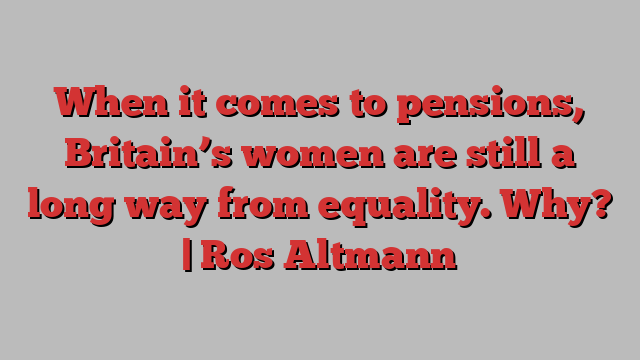
In 21st-century Britain, there is still a shocking gap between men’s and women’s pensions. While public discourse has been dominated by the gender pay gap, which has been almost eliminated for women under the age of 40, women remain the poor relations when it comes to financial security in later life.
Official figures show most of the UK’s poorest pensioners are single women. This will not be easily resolved and the gender pensions gap exists in many other countries too. However, the very low level of state pension provision in the UK means that those who have little or no private pension wealth are at a serious disadvantage in retirement.
The chancellor, Jeremy Hunt, is reportedly planning to announce changes in the annual tax-free allowance for pension contributions, increasing it from £40,000 to £60,000 in tomorrow’s budget, as well as increasing the lifetime allowance (LTA) – the maximum amount workers can pay into their pension pot tax-free – by more than £500,000.
The chancellor is planning to improve childcare support for working mothers. That can help more women stay in work, but many will still only work part-time. In addition, the problems in adult social care will mean many older women leaving full-time work to care for older relatives.
First, we need to understand why this disparity exists. A principal reason for the gender pensions gap is simply that women have lower lifetime earnings. Over a typical working life, caring responsibilities usually mean women earn less than men. Since private pensions depend on earnings, this means women will have lower pensions.
Research shows that after having a first child, men’s earnings will generally keep rising, but women’s do not. Women are also more likely to work part-time, or in jobs that have lower average pay than those men have. Recent ONS figures show the number of women leaving the workforce to look after family has risen by 3% in the past year.
Even in later life, after their child-caring years, women are more likely to work part-time or retire early to look after loved ones, leaving them at risk of less retirement income.
The inadequacies of our country’s care provision – both for children and older adults – remain a serious obstacle to women’s earnings and pension prospects. Many undertake unpaid caring for loved ones, but that leaves less time for paid work. With an ageing population, these problems will only worsen without serious reforms.
The gender pensions gap is also ingrained in the revolutionary workplace pension auto-enrolment policy, leaving many women at risk of lower pensions than men. Only those earning more than £10,000 a year in any one job are eligible to be automatically enrolled. Those with multiple jobs, each paying below £10,000, are completely excluded, which is estimated to leave out more than 3 million women.
Another problem for low-paid women is that some employer schemes force those earning less than £12,570 a year to pay 25% extra for their pensions, which may mean more simply opt out altogether. Well over 1 million women are affected by this problem and although the Treasury has promised to remedy the injustice, this will not be done before 2025.
Divorce can also cause women to lose out in later life. The government introduced the excellent idea of divorced women sharing their former partner’s pension. But the lack of financial awareness and the inadequacy of protections for divorcing women leaves many losing out significantly when their partner fails to properly disclose the correct value for their pension. If the wife cannot afford good legal assistance, or simply trusts that the value given by their husband is correct, they can be seriously short-changed.
Not only are women losing out significantly in private pensions, but even more worryingly they lose out in state pensions too. After decades of inequality in the national insurance system, even the new state pension, introduced in 2016, sees women losing out. This seems astonishing, as the new system is supposed to offer a flat-rate state pension without earnings-related elements. Nevertheless, women are still forecast to have about £10 a week lower pensions than men, based on the full state pension amount (albeit down from £30 a week). The gap is not forecast to close until the 2040s.
This is partly because of the vestiges of the old system, but there are also elements of the qualification criteria that disadvantage women. For example, the child benefit means test requires women, even if they know they will receive nothing, to apply for the benefit or else they lose credit for their state pension. Women earning less than the national insurance lower earnings limit (LEL) receive no credit towards their state pension. They may have several jobs, each earning below the LEL, and still get no state pension credited.
These unreasonable, inflexible rules penalise thousands of women. Such anomalies have no place in a 21st-century system and the government should fix them urgently.
What else can the government do to improve women’s pension outcomes? Reducing the auto-enrolment thresholds to bring in those earning less than £10,000 a year would clearly help. Also, improving workplace financial education to help women understand pensions, and protecting women’s pensions more robustly after divorce. Another revolutionary reform could consider ways of helping women and their partners to contribute to pensions during caring years and encouraging stay-at-home women to ask partners to make pension contributions for them.
Although women lose out in both state and private pensions, there are ways of fixing some of the cracks that they are falling through. Encouraging women to take responsibility for their pensions by improving awareness will also help. Much to do; let’s hope it will happen.